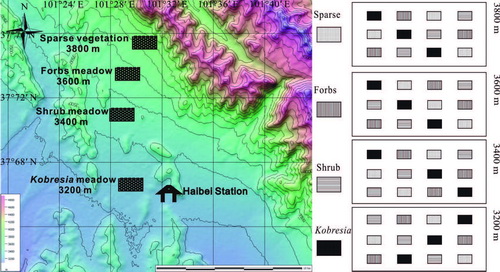he great sensitivity of the response of alpine plant community to climate change makes the identification of these responses important. In 2007, we conducted a reciprocal translocation experiment on 100 × 100 × 40 cm coherent turf and soil along an elevation gradient of 3200–3800 m on the south slope of Qilian Mountains northeast of the Qinghai-Tibetan Plateau. The aim was to understand the warming/cooling effects on the alpine ecosystem where treatments were simulated by donor elevations below/above receptors. Translocated vegetation comprised the Kobresia meadow at 3200 m, deciduous shrub meadow at 3400 m, forbs meadow at 3600 m, and sparse vegetation at 3800 m. The 5 × 5 cm grid method (50 × 50 cm, 100 grids) was used for surveying plant species absolute abundance in translocated quadrats. Results showed that species richness and Shannon-Weaver index of Kobresia meadow increased significantly (P <0.05) when translocated to 3400 m. Shannon-Weaver index of shrub meadow declined, while shrub species abundance responded slightly both to warming and cooling treatments. Both species richness and Shannon-Weaver index of forbs meadow and sparse vegetation were enhanced evidently at 3200 m and 3400 m. Four groups were identified by non-metric multidimensional scaling based on receptor elevation. Responses of the alpine plant community and the function group appeared to be specific to climate magnitude and specific to function type, respectively. Correlation indicated that climatic factors played a much more important role than soil in the response of the alpine plant community. Four vegetation types were sensitive to climate change, while Kobresia meadow behaved flexibly. Global warming would depress sedges but favor legumes and graminoids.

Fig. Location map of the four vegetation types (left) and the diagram of reciprocal translocation experiment
(right).
Additional Information:
1. Author Information:Fa-Wei Zhang, Ying-Nian Li, Guang-Min Cao, Shi-Ping Wa Ng, Xin-Quan Zhao, Ming-Yuan Du, Qin-Xue Wang
Correspondence: E-mail address: fwzhang@nwipb.cas.cn
2. Published : POLISH JOURNAL OF ECOLOGY, 59(4): 741–751, 2011
